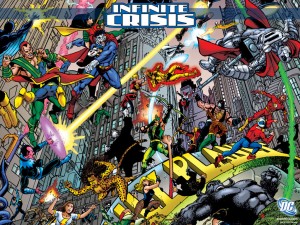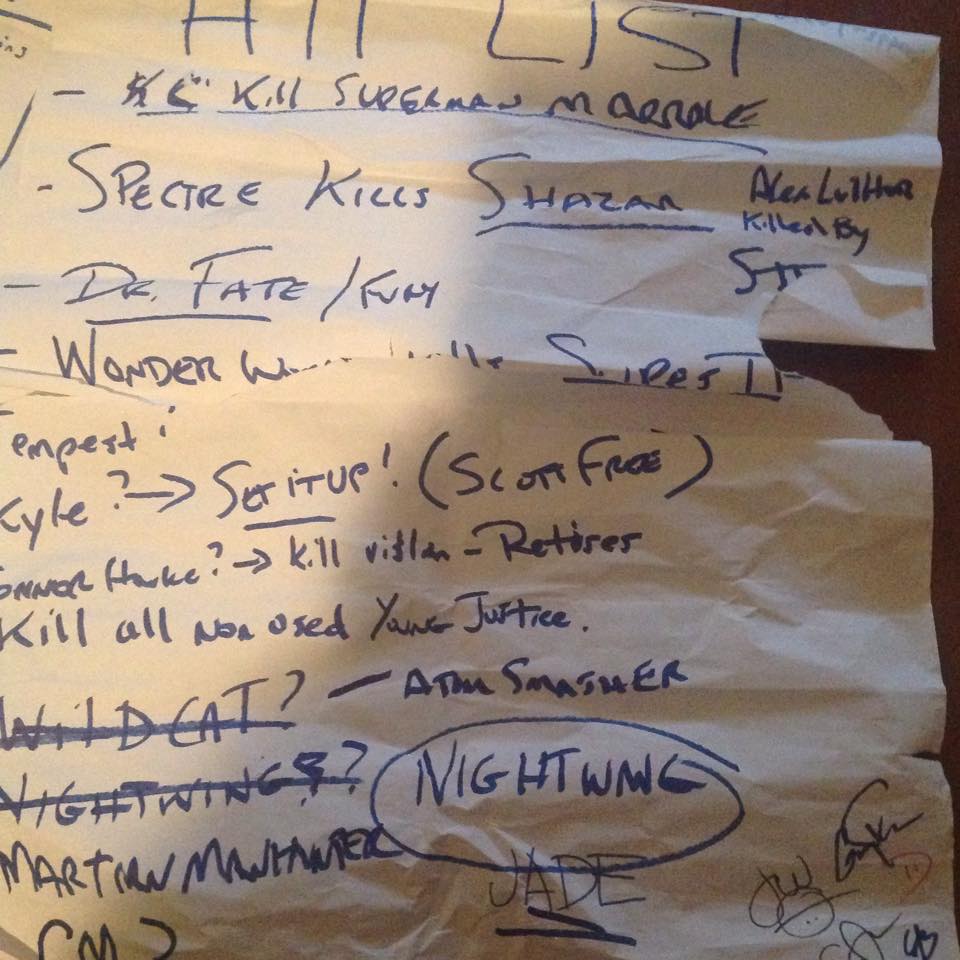By Alexander Jones
Modern comic events usually spell out impending doom for a select few of the superheroes we have grown to love. DC Comics Co-Publisher Dan Didio gave some insight into the publishing company process on how they decide which of these heroes stay among the living, and which others enter the revolving door of comic book death. A white board attached to the planning stages on Infinite Crisis, a DC Comics event that riffed on the 1985 classic Crisis on Infinite Earths storyline was shared by Didio via Facebook.
Lately the Co-Publisher has been sharing other thoughts and ramblings on his career as well.
There is actually something that he calls a ‘hit list’ mentioned on the page, which seems to outline some of the major plot beats of the event. The ‘hit list’ also breaks down of some of the deaths that were meant to happen in the original plot for Infinite Crisis. Similar to DC’s latest Forever Evil event, there is reference to the death of Dick Grayson as Nightwing and a whole lot more.
Just goes to show you what I know and how I remember it. It seems that life needs to imitate art as I have to retcon my last posting slightly. As the fates would have it, right after I finished writing I went back to cleaning the basement and came across some of the original whiteboard pages I saved from the initial meeting (see attached to this post) where the road to Infinite Crisis was paved. It appears my dates were off. My conversation with Grant on Hypertime was actually in 2003 prior to his signing with DC and the meetings that led to Infinite Crisis were in early 2004.
Now, back to the story, but first, a confession (not a surprise), I love comic book continuity. I love the idea of a shared universe and how stories can weave and connect to create an even greater story. It’s what hooked me on comics in the first place and held me to this very day. Granted, continuity can also constrict ideas and be a crutch for lazy storytelling, but when done right, there’s nothing more exciting than watching a universe (or multiverse) unfold and build in front of you. And in my early meetings with Paul, when I first because Executive Editor, I talked about how we could produce stories that looked at the line as a whole rather than individual titles or character lines. That way, all boats would rise together.
Judd Winick, Greg Rucka and Geoff Johns were doing great work for both Marvel and DC when I broke into the business and I made it my business to get them over to DC exclusively. Geoff had a clear voice and vision of the DC Universe with an understanding that moved the characters into the future while honoring the past, Judd had heart, humor and a willingness to try anything that allowed him to push boundaries, and Greg had a gravitas, focus and attention to detail that gave every character and story he wrote depth and weight. An equilateral triangle of talent. Once signed, we went right to work setting the course of the universe. For three days we meet, along with DC Editor Eddie Berganza, at the Warner Bros. lot in Burbank and charted the course for the DC Universe. It was a two year plan that started with Identity Crisis and finished (for the moment) with Infinite Crisis. The goal was to create a defining moment every few months that the universe could rally around, each time raising the stakes as we built to Infinite Crisis. At the time of this meeting, Greg, Judd and Geoff were writing a Batman title, a Superman title, Wonder Woman, Green Arrow, Green Lantern, Flash, JSA, Titans, and Outsiders (and they were about to add Shazam and JLA to the mix), so regardless of any other writers joining in the story, they could carry it themselves with the collective weight of their own titles. (the idea for the Countdown one shot and the four Road to Infinite Crisis mini-series would come later).
As I said earlier, I love continuity but I also know, first hand, how frustrating it can be. While I was on Superboy with Jimmy Palmiotti, we were asked to participate in a crossover that not only interrupted our story, but forced us to rewrite three issues. Not the best of experiences. So the plan was to give as much advance warning and flexibility to the other series with the hope other writers and titles would follow suit and join in the story.
Even that worked out better than we imagined.
PS. Photos of the original whiteboard pages of timeline for Crisis, with the original HIT LIST, always fun to see where we started now that we know where it ended up. Most importantly, no matter what we planned or did, none of it would have mattered without the fans love and support. My thanks to all you who went with us and continue to join us in this amazing ride. All the best, DD













Wow. I guess if they couldn’t be killed off, they’d just get written into the ground instead. Dan Didio sucks.
Kyle Raynor
Connor Hawke
Nightwing
Tempest
Young Justice
Dr. Fate & Fury
Atom Smasher
What is this bizarre fixation that DC execs have with killing legacy characters and, if I’m reading the top item correctly, scuttling marriages? It’s as if anything that didn’t exist in 1965 is in constant danger of being rubbed out by the silver age nostalgia mafia.
The obsession with killing the Supermarriage is actually kind of creepy. There was nothing wrong with Superman being married to Lois Lane. It was a different kind of story with realistic tension where Lois was treated as an equal player in the know. And it was killed so that middle aged men having a midlife crisis could relive their fanboy youth by hooking Superman up with Wonder Woman. If that’s not the biggest example of editorial midlife crisis meddling then I don’t know what is.
Comments are closed.